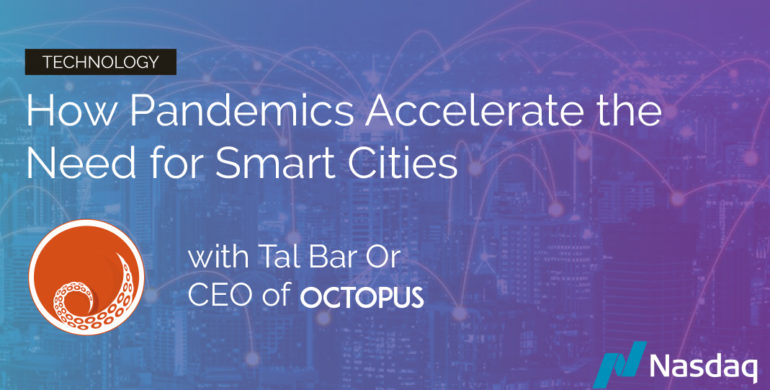By Tal Bar-Or, CEO of OCTOPUS
Countries around the world have responded to the pandemic with various strategies, ranging from full lockdowns enforced by draconian measures to governments merely encouraging their populations to implement distancing. One recurring theme has prevailed: Across the board, countries are striving to implement technologies effectively and seamlessly to mitigate the consequences of social distancing, but they are struggling to achieve this.
Why is that? The necessary technologies are already out there. Positioning systems, cybersecurity systems, and physical security systems exist. Most necessities are on the grid, and everyone is online. What COVID has made clear is that these technologies are still just a patchwork. For quite some time, the buzz surrounding the potential for “Smart Cities” has infiltrated our public discourse.
Today, however, it is more evident than ever that we can reach the potential they offer faster than anyone thought, if only we devoted enough resources to the task. By utilizing integrated technologies to put together the tremendous technological tools already at our disposal, we could already have smart cities worldwide. Smart cities enable too many services to list, but a few, in particular, are ripe for mass deployment.
Transport and logistics
Contactless delivery of goods and food is a great example. Autonomous vehicles, or even drones, can perform the deliveries, which will minimize the physical contact needed to deliver goods. This type of automation works for other parts of the supply chain as well. Industrial automation can reduce the dependence on human resources by changing the way we manage logistics.
Think of the potential autonomous vehicles have in affecting the twenty-four-hour rhythm. Assuming it can be done quietly, deliveries and logistics work can be done throughout the night, boosting the performed labor hours of critical industries. However, this kind of change is on the extreme end. What could happen tomorrow, however, with the right coordination, is a shift to off-hour deliveries. This would require utilizing existing smart technologies to coordinate and manage truck activity as well as implementing thought-out traffic strategies to manage local freight.
Health and disease care
Telehealth solutions in an interconnected world are essential in this type of public health crisis. Much of the conversation surrounding the ripple effects of COVID has to do with the economy. One of the fields that have taken a giant leap forward is telehealth, though still only in a fragmented way.
One system measures a person’s temperature, while an entirely different system measures patients’ blood pressure. Remote monitoring is done with one device, and a conversation with a doctor might only happen after waiting in a phone queue for 45 minutes. Streamlining how health is managed through the technological infrastructure in a city is crucial to maximizing the utilization of multitudes of health technologies, which can significantly improve a city’s health situation.
Hospitals are deploying IoT solutions at a higher rate now than before. One forecast indicates that medical IoT revenues will rise more than 230 percent by 2024. They are fueled by price pressure and the need to get maximum utilization and lifetime out of expensive machinery. Through smart IoT technology, machines and equipment can be monitored and managed via the cloud. Devices can be equipped with sensors that detect out-of-spec performance, or when maintenance is needed and such. These kinds of technological leaps were available and vital before, but the pandemic has laid bare that we can manage all of it in a better way already. The entire health and disease-care system must be on top of its game today, not only in the future.
Surveillance
While societies keep discussing thorny issues surrounding data collection and monitoring, it is clear that technology enables remote inspections of civic violations effectively. Now we can utilize drones, and people’s mobile devices, for example, to ensure people follow social distancing measures directives. Or when we use touchless devices to measure people’s temperature, the device can also check if one is wearing a mask.
The multitude of technologies need not only be one-way communication. It seems that now we are content with having a sensor to measure a person’s temperature, which will determine if access to a specific venue is granted. But imagine the power of this data feeding into a more centralized system. Of course, we must be mindful of privacy concerns, but let’s not lose sight of the enormous upside these technologies have, not only in managing crises, but also making our daily lives run smoothly.
Cities and their technological infrastructures weren’t built with issues like pandemics in mind. Cities and technologies have grown through incremental improvements. These improvements compound into tremendous progress, but now we have the ability to integrate these technological steps into smart societal leaps. This pandemic is a chance to reevaluate how we build cities and the way we utilize technologies. While the political sphere deals with crucial emergency measures to stave off immediate health dangers, we must consider how to combine and utilize already-available technologies in light of the challenges that were always there, but only now are exposed.
About the Author:
Tal Bar-Or is a founding partner and CEO of OCTOPUS. He has global expertise in strategic concept design and master security planning in the fields of aviation security, mass transit, critical infrastructure, information security, and loss prevention. The OCTOPUS application was designed based on his experience and expertise acquired during his years of security consulting for high-end clients around the world. Before founding OCTOPUS, Tal served in the Israel Security Agency for more than 13 years. He has also held multiple security positions at the Israeli Airport Authority and worked in the security division of EL AL Airlines. His last position was as the Security Manager for the EL AL Airlines stations in Toronto and Paris from 2005 to 2010. Tal holds an M.A. in Communication from the University of Paris 8 Saint-Denis and a B.A. in Economics and Business Administration from Ariel University.



